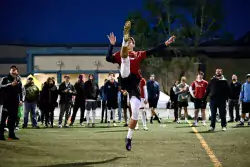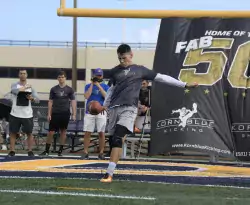kickers

Previously: Last year’s profiles.
| West Bloomfield, MI – 6'4", 181 | |||||||||||||||||||
 |
Kornblue: | #2 P, #1 Combo | |||||||||||||||||
| Kohl’s: | 5*, #6 K, #2 P | ||||||||||||||||||
| Chris Sailer | 6*, #1 P 5*, #11 K |
||||||||||||||||||
| Prokicker | Not ranked | ||||||||||||||||||
| Other Suitors | Army, AF, WMU, BC | ||||||||||||||||||
| YMRMFSPA | Kenny Allen | ||||||||||||||||||
| Previously On MGoBlog | Hello post from Ace. | ||||||||||||||||||
| Notes | Twitter. | ||||||||||||||||||
|
Film |
|||||||||||||||||||
|
Kohl's Highlights: Senior Year:
|
|||||||||||||||||||
Editor’s Note: Because the major sites don’t really pay attention to specialists, and there are now three sites who do, we are going to use those.
Michigan was in the market for specialists year since Brad Robbins and Jake Moody are fifth- and fourth-year players with junior eligibility thanks to the Covid year, and Will Hart (SJ State) and Quinn Nordin (Patriots) just moved on. Luckily there was an elite combo prospect at OLSM who grew up rooting for Michigan who’s been on the kicking radars since he was in 5th grade:
As great as his stats are, perhaps Doman’s most impressive kick came when he was in fifth grade and he hit a 32 yard field goal – in a game. In fact, it was the first in-game field goal he ever kicked.
“People were like, ‘Oh my gosh, that’s so unheard of for a fifth grader to make a field goal.’ I was like, maybe I can continue working hard, I can maybe build something out of this.”
Ten(!) years later he’s averaging 45 yards per punt and is the Wolverines’ second-ever specialist invited to the All-American game, after the Great and Powerful Zoltan Mesko. Michigan intends to use Doman in all three phases. Harbaugh:
Punter, kicker, kickoff guy. He really does it all. You never know, one of the best punters or kickers around to be able to do all three things as good as anybody in the country at all three. If not the best. I think Tommy Doman—you’ve gotta be real good to be offered a scholarship out of high school as a punter or kicker. He can do both at a really high level.
[Hit THE JUMP for the boom]

While watching college football games from the mid-80s to mid-90s for the "Let's Remember Some Games" series, one of the most difficult—and fun—parts of the game to track has been the myriad tweaks to the kicking rules. For instance, from 1948-88, placekickers were allowed to use a tee on extra points and field goals in the NCAA. The goalposts were also five feet wider from 1959-90 than the current standard.
As we saw in the 1985 Notre Dame game, these rules made kickers like John Carney serious threats once their offenses crossed midfield. They were even bigger long-range threats before 1978, when all missed field goals were treated like touchbacks—opponent's ball at their 20-yard line—instead of giving the opponent the ball at the previous line of scrimmage. Watching that game led me to look up the kicking tee rules, which in turn led me to this incredibly comprehensive page of the longest field goals in history, one that also details rule changes and how each kick was made. They even have high school kicks.
You can get lost in that page and looking up related tidbits for hours. Before I get into the ostensible purpose of this post, a quick and not at all comprehensive list of amazing facts contained therein:
- As you'd suspect, most of the longest field goals come from prior to 1978, when kickers used two-inch tees (they'd been one inch until 1964) and teams didn't face huge field position consequences for attempting long bombs. The record across all divisions is a nice 69 yards by NAIA Abilene Christian's Ove Johansson in 1976, the Swede's only season playing college ball after transitioning from soccer. He went 1-for-4 on field goals for the Philadelphia Eagles before moving on to a career in business.
- The very next person on the list is Dirk Borgognone, who crushed a 68-yarder for Reno High School in 1985. It was the only field goal of his football career.
- This passage: "In early 1920's Cornell had players build a hill of dirt and more than one player thus held the ball higher for the placekicker. Referees eventually called this a penalty."
- Steve Rainey, playing on a 7-on-7 flag football team in 1991, made a 67-yard field goal off a one-inch wood block tee—barefoot. It's the longest barefoot kick on record. Also, I told you this list was comprehensive.
- I urge you to read the newspaper report after Princeton's John Triplett Haxall booted a 65-yarder against Yale at the Polo Grounds in 1882.
- Ten years later, Birmingham A.C.'s J.P. Ross connected from 65 yards on a drop kick, the longest such kick in history. They beat Alabama, 5-4. The Tide's occasional run-in with horrible kicking luck dates back to the 19th century.
- In 2002, Ola Kimrin made a 65-yard field goal in the preseason for the Denver Broncos, which would be an NFL record if it had occurred in the regular season. Denver released him after the game.
- Big Ten, baby: "62 yards Pat O'Dea, Wisconsin (W 47-0) at Northwestern, 11/24/1898 (drop-kick) [in blizzard] (also has never to be broken longest punt: 110 yards, 1898) [also kicked 60 yarder in Australia, see below, • Only player to do so in both lands.]"
- A semi-pro player named Fabrizio Scaccia had a 62-yarder wiped out by an illegal formation penalty. No word on whether he quit on the spot, unfortunately.
- Michigan State's Ralf Mojsiejenko had a 60-yard kick nullified by a penalty in the 1984 Cherry Bowl, held at the Pontiac Silverdome. He missed the ensuing 65-yarder. State lost to Army, 10-6.
I could go on for ages, but it's time to focus on the real point of this post: 1940s Wisconsin high school football.

Yes, in Wisconsin, for a period of time, you could get three points for hitting the ball through the uprights on a kickoff. This was far-fetched but doable for high schoolers with the tee at the 40-yard line and goalposts on the goal line instead of the back of the end zone.
[Hit THE JUMP for PLEASE DO THIS now updated with STATISTICAL JUSTIFICATION]

Previously: Krushed By Stauskas (Illinois 2014), Introducing #ChaosTeam (Indiana 2009), Revenge is Terrifying (Colorado 1996)
This series: Four Games In September I (Boston College 1991), Four Games In September II (Boston College 1994), Four Games In September III (Boston College 1995)
This game: WolverineHistorian highlights
For the first time heading into a game of this series, Michigan and Boston College both hold onto their head coaches. After both teams turned in disappointing 1995 seasons, they're at least afforded offseasons without coaching turmoil. Naturally, the 1996 game and its aftermath are the messiest of the series.
The Wolverines are ranked eighth in the country after opening the season with wins over Illinois and at #5 Colorado. Boston College is giving Matt Hasselbeck his second start after he came off the bench to lead a comeback win in the opener at Hawaii; 1996 Drew Bledsoe couldn't have saved the Eagles from a 45-7 pasting at the hands of rival Virginia Tech in game two.
Third-year head coach Dan Henning, perhaps in an attempt to keep expectations low for his own sake, doesn't exactly give the home team any bulletin board material (via the Michigan Daily archives):

Let's take a peek ahead and see if this gambit worked:

Well, I'll be damned.
[Hit THE JUMP for fumbles, a biblical downpour, Jarrett MFing Irons, and a gambling scandal.]

come for the kicker highlights, stay for the kicker weightlifting numbers

i dub thee "punty eaglet"
33